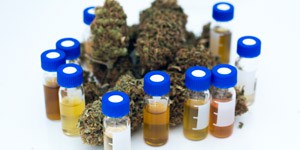By Ismael Galve-Roperh

Ismael Galve-Roperh, Biochemist and molecular biologist with over 20 years experience in cannabinoid research. He has made some major contributions, including discovery of the anti-tumoral role of cannabinoid signalling, its neuroprotective effects in neurodegenerative diseases and the impact of these compounds on neurodevelopment.
Consumption of cannabinoid compounds (molecules derived from the Cannabis sativa plant) has a wide variety of effects on the body, acting through the nervous system, and also on many other tissues and organs. Of the more than 100 cannabinoid-type molecules in the plant, some act by imitating endogenous molecules or endo-cannabinoids.
These endo-cannabinoids act as messengers in a system of cell signalling which we call the endocannabinoid system (ECS). (Lu and MacKie 2016). Among the main endo-cannabinoids are 2AG (2-arachidonoylglycerol). 2AG is a lipid which is synthesised in the nervous system in response to neuron activation. 2AG regulates neuron communication, reducing the release of neurotransmitters in different types of synapse through a specific receptor, the cannabinoid CB1 receptor. The neuromodulating role of CB1 receptors and the ECS in general, is the main known physiological function of this signalling system. Altering cannabinoid signalling influences neuronal communication, and thus modulates the appearance of neurological and psychiatric disorders.
As well as regulating neuronal communication, both the cannabinoid CB1 receptors and CB2 receptors regulate intracell signalling paths that influence essential cell processes such as cell proliferation, differentiation, survival and death (Maccarrone et al. 2014). In the NS, these actions by the ECS during neurodevelopment can lead to the generation, differentiation and maturation of neurons, or their integration in neuronal circuits. For this reason, changes in the expression or activity of the ECS —for genetic reasons or due to exposure to molecules that interact with it— significantly affect key processes of neurodevelopment which subsequently impact the functionality of the nervous system in adulthood.
Cannabis and the endocannabinoid system in neurodevelopment
Exposure of the immature brain to phytocannabinoids has a notable influence on neuron functionality. For several reasons, this influence is significantly different to the influence on the adult brain. The effect of cannabis on the adult brain occurs mainly as a result of modifying neuronal activity. Such changes can be reversed, to a large extent at least, once consumption is discontinued. In embryonic stages, changes in the activity of the ECS are liable to influence the quantity of neurons formed, their characteristics and their functional properties. In postnatal stages, changes in cannabinoid signalling can affect the maturation of neuronal circuits and coordination of neuronal activity. Processes of elimination and/or consolidation of synapses occur during adolescence, and myelinization processes continue up to the teen years. For example, embryonic and postnatal exposure to cannabinoids determines changes in neuronal connectivity between different regions of the brain and the ECS regulates the survival of the cells responsible for the formation of myelin (oligodendrocytes).
It is important to note that when studying the consequences of altering cannabinoid signalling in neurodevelopment, it is normal to use isolated molecules. Most commonly, regulators of the CB1 receptor are used. These molecules are much more powerful than the endo-cannabinoids and phytocannabinoids that affect this receptor. Studying the effect of each of the phytocannabinoids separately shows the individual isolated effect of each molecule but is of limited use in drawing conclusions on cannabis use. Cannabidiol (CBD) is a paradigmatic example; co-administration of CBD with other cannabinoids such as THC (and other activators of the CB1 receptor) attenuates both the molecular and behavioural processes they induce (Campos et al. 2017). THC has pro-psychotic effects which are attenuated by CBD, and CBD in itself has antipsychotic effects in schizophrenia. CBD is capable of attenuating some of the positive symptoms characteristic of disease, but it also has beneficial effects at a cognitive level. A summary is given below of the main findings of recent research showing the role of cannabinoids in regulating neurodevelopment.
Cannabinoid signalling during embryonic and postnatal development
During the embryonic period many processes involving neuronal generation, death, differentiation and connectivity all take place rapidly. These processes are regulated by extracellular signalling systems, such as the ECS. The ECS regulates intrinsic factors of the cell, determining whether or not it divides (and into what neuronal type it differentiates) or dies. Laboratory studies have investigated the consequences of over-activation or lack of cannabinoid signalling in neurodevelopment in experimental animals (e.g. in mice). Genetic deletion (absence) of the cannabinoid CB1 receptor or the enzyme responsible for producing 2AG causes changes in the proliferation of stem cells in the NS. Similarly, pharmacological regulation using cannabinoids that activate the receptors (agonists), or molecules that augment the endocannabinoids (inhibitors of degradation) increase stem cell proliferation (Galve-Roperh et al. 2013). As yet, we do not know whether the changes in neuronal generation induced by these genetic or pharmacological changes carry on into adulthood or are compensated for and lost.
Cannabinoid CB1 receptors also influence neuronal differentiation and connectivity. Again, studies of genetic elimination of different genes in the ECS (receptors, enzymes of synthesis and degradation) or pharmacological regulation with exogenous cannabinoids show changes in neuronal differentiation and connectivity. CB1 receptors regulate the gene expression responsible for neuronal differentiation, for example by regulating the formation of populations of specific excitatory neurons in the cortex. The balance between synthesis and degradation of the endocannabinoid 2AG and the CB1 receptors regulates the growth (or collapse) of the growth cone of the axon whereby neurons advance to establish their connections. The formation of other essential types of neuron population is also regulated by the ECS. Cannabinoid signalling regulates the development of certain types of interneurons, inhibitory neurons which control the activity of others and are essential for coordinating activity and establishing neuronal rhythms. Changes in the activity of inhibitory or excitatory neurons contribute to an imbalance of neuronal activity, causing seizures and epilepsy and some of the symptoms of neuropsychiatric disorders.
The process of maturation of the NS continues in adolescence. This is an active period of remodelling of synapses and circuits controlled by neuronal activity, genetic programming and environmental influence. Throughout this development there are a number of time windows in which the cellular and physiological processes taking place are more susceptible to environmental influence (critical periods). Once these critical periods have concluded (i.e. the "windows" have closed), the processes are more resistant to adaptive changes. Administration of cannabinoid compounds in the embryonic and postnatal state influences neurochemical maturation and the consolidation of neural networks. These adaptations induce changes in the excitatory and inhibitory balance, and therefore have an influence by favouring or reducing neuronal hyper-excitability and the appearance of seizures. Exposure to THC produces, among others, changes in the prefrontal cortex of the glutamatergic and GABAergic system, alterations in the dopaminergic system that influence cognitive functions, motor functions, emotional aspects and psychotic symptoms.
Health implications
When examining the role of the ECS in regulating neurodevelopment, it is important to consider that the stages in which active processes of neurodevelopment are still taking place are especially sensitive to the consequences of altering the physiological functioning of this signalling system. To date, no neurological or psychiatric disorders have been unequivocally associated with genetic mutations or polymorphisms of the ECS. In any case, there is a genetic association that demonstrates the influence of cannabinoid signalling in the incidence of schizophrenia and the risk of psychotic breaks. There are numerous indications that THC and other cannabinoids can contribute to the appearance of psychotic breaks or act as a trigger of schizophrenia in people with a genetic predisposition ("second hit") (Volkow et al. 2014). The findings of longitudinal studies on the use of THC highlight a greater risk of developing the disease with early use and in high doses. For these reasons, cannabis use among adolescents and high-risk groups should be discouraged and objective education policies created to prevent early abuse.
At the same time, certain actions of cannabinoids in the NS have been shown to have clinical potential for treating some symptoms of neurodevelopmental disorders. Cannabidiol (CBD) has been demonstrated to be effective in reducing seizures in children with refractory epilepsy —as is the case with Dravet's diseas, Gaston-Leroux's disease, cortical dysplasia, tuberous sclerosis and febrile seizures— and the use of Epidiolex (GW Pharma) has been approved for some of these disorders. In any case, rigorous new preclinical and clinical studies are required to determine the possible effectiveness of new cannabinoid formulations (with a different profile of pharmacological action and composition) in treating seizures and epilepsy. At the same time, and in the absence of any specific clinical trials, the use of small doses of cannabinoids that act through the CB1 receptor, such as THC, could make it possible to combine an anticonvulsant effect with an improvement in aspects of social and emotional interaction in patients with refractory epilepsy or autism spectrum disorder.
Conclusions
i) Cannabinoids —both endogenous molecules and those derived from the cannabis plant— are capable of influencing the development of the nervous system.
ii) The consequences of exposure to cannabinoids during active stages of neurodevelopment or during maturation of the nervous system differ in intensity and characteristics from the consequences of consumption in adulthood.
iii) Exposure to THC during embryonic development has effects on neuronal formation and differentiation that subsequently condition the functioning of the adult brain.
iv) Consumption of THC in adolescence induces processes of neuronal plasticity and adaptive changes in neuronal activity, communication and coordination.
v) Cannabinoids that are capable of regulating CB1 receptors induce dual changes in neuronal hyperexcitability (reducing or increasing it) and also influence behavioural aspects.
vi) Altering cannabinoid signalling, because of its capacity to regulate neuronal development, can induce neurological and psychiatric alterations. In a complementary fashion, cannabinoids can modulate some of the functional alterations caused neurodevelopmental disorders.
Bibliography
Campos AC, Fogaça MV, Scarante FF, Joca SRL, Sales AJ, Gomes FV, Sonego AB, Rodrigues NS, Galve-Roperh I, Guimarães FS. 2017. Plastic and neuroprotective mechanisms involved in the therapeutic effects of cannabidiol in psychiatric disorders. Front Pharmacol. 8.
Galve-Roperh I, Chiurchiù V, Díaz-Alonso J, Bari M, Guzmán M, Maccarrone M. 2013. Cannabinoid receptor signaling in progenitor/stem cell proliferation and differentiation. Prog Lipid Res. 52:633–650.
Lu HC, MacKie K. 2016. An introduction to the endogenous cannabinoid system. Biol Psychiatry. 79:516–525.
Maccarrone M, Guzmán M, Mackie K, Doherty P, Harkany T. 2014. Programming of neural cells by (endo)cannabinoids: from physiological rules to emerging therapies. Nat Rev Neurosci. 15:786–801.
Volkow ND, Baler RD, Compton WM, Weiss SRB. 2014. Adverse Health Effects of Marijuana Use. N Engl J Med. 370:2219–2227.


